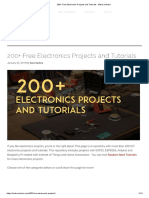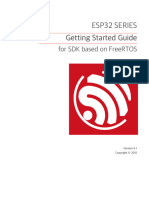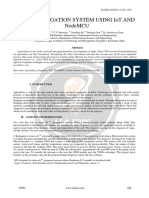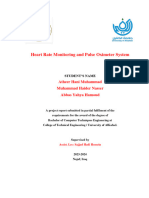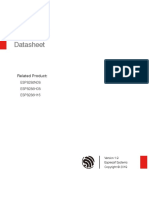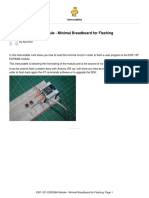What is ESP32?
ESP32 is a low-cost System on Chip (SoC) Microcontroller from Espressif Systems, the developers of
the famous ESP8266 SoC. It is a successor to ESP8266 SoC and comes in both single-core and dual-
core variations of the Tensilica’s 32-bit Xtensa LX6 Microprocessor with integrated Wi-Fi and
Bluetooth.
The good thing about ESP32, like ESP8266 is its integrated RF components like Power Amplifier,
Low-Noise Receive Amplifier, Antenna Switch, Filters and RF Balun. This makes designing hardware
around ESP32 very easy as you require very few external components.
Another important thing to know about ESP32 is that it is manufactured using TSMC’s ultra-low-
power 40 nm technology. So, designing battery operated applications like wearables, audio equipment,
baby monitors, smart watches, etc., using ESP32 should be very easy.
�Specifications of ESP32
ESP32 has a lot more features than ESP8266 and it is difficult to include all the specifications in this
Getting Started with ESP32 guide. So, I made a list of some of the important specifications of ESP32
here. But for complete set of specifications, I strongly suggest you to refer to the Datasheet.
Single or Dual-Core 32-bit LX6 Microprocessor with clock frequency up to 240 MHz.
520 KB of SRAM, 448 KB of ROM and 16 KB of RTC SRAM.
Supports 802.11 b/g/n Wi-Fi connectivity with speeds up to 150 Mbps.
Support for both Classic Bluetooth v4.2 and BLE specifications.
34 Programmable GPIOs.
Up to 18 channels of 12-bit SAR ADC and 2 channels of 8-bit DAC
Serial Connectivity include 4 x SPI, 2 x I2C, 2 x I2S, 3 x UART.
Ethernet MAC for physical LAN Communication (requires external PHY).
1 Host controller for SD/SDIO/MMC and 1 Slave controller for SDIO/SPI.
Motor PWM and up to 16-channels of LED PWM.
Secure Boot and Flash Encryption.
Cryptographic Hardware Acceleration for AES, Hash (SHA-2), RSA, ECC and RNG.
Different Ways to Program
A good hardware like ESP32 will be more user friendly if it can be programmed (writing code) in more
than one way. And not surprisingly, the ESP32 supports multiple programming environments.
Some of the commonly used programming environments are:
Arduino IDE
PlatformIO IDE (VS Code)
LUA
MicroPython
Espressif IDF (IoT Development Framework)
JavaScript
As Arduino IDE is already a familiar environment, we will use the same to program ESP32 in our
upcoming projects. But you can definitely try out others as well.
�ESP32 DevKit – The ESP32 Development Board
Espressif Systems released several modules based on ESP32 and one of the popular options is the ESP-
WROOM-32 Module. It consists of ESP32 SoC, a 40 MHz crystal oscillator, 4 MB Flash IC and some
passive components.
The good thing about ESP-WROOM-32 Module is the PCB has edge castellations. So, what third-part
manufacturers do is take the ESP-WROOM-32 Module and design a break-out board for this module.
One such board is the ESP32 DevKit Board. It contains the ESP-WROOM-32 as the main module and
also some additional hardware to easily program ESP32 and make connections with the GPIO Pins.
��Layout
We will see what a typical ESP32 Development Board consists of by taking a look at the layout of one
of the popular low-cost ESP Boards available in the market called the ESP32 DevKit Board.
The following image shows the layout of an ESP32 Development Board which I have.
IMPORTANT NOTE: There are many ESP32 Boards based on ESP-WROOM-32 Module available
in the market. The layout, pinout and features vary from board to board.
The board which I have has 30 Pins (15 pins on each side). There are some board with 36 Pins and
some with slightly less Pins. So, double check the pins before making connections or even powering up
the board.
As you can see from the image, the ESP32 Board consists of the following:
ESP-WROOM-32 Module
Two rows of IO Pins (with 15 pins on each side)
CP2012 USB – UART Bridge IC
micro–USB Connector (for power and programming)
AMS1117 3.3V Regulator IC
Enable Button (for Reset)
Boot Button (for flashing)
Power LED (Red)
User LED (Blue – connected to GPIO2)
Some passive components
An interesting point about the USB-to-UART IC is that its DTR and RTS pins are used to
automatically set the ESP32 in to programming mode (whenever required) and also rest the board after
programming.
�Pinout of ESP32 Board
I will make a separate dedicated tutorial on ESP32 Pinout. But for the time being, take a look the
pinout diagram of the ESP32 Development Board.
This pinout is for the 30 – pin version of the ESP Board. In the pinout tutorial, I will explain the pin out
of both the 30 – pin as well as the 36 – pin version of the ESP Boards.
Conclusion
This is a complete beginner’s tutorial on ESP32, an excellent SoC with integrated Wi-Fi and Bluetooth
connectivity. You learned about the ESP32 Microcontroller, its specifications, development board
layout and a brief pinout as well.









































